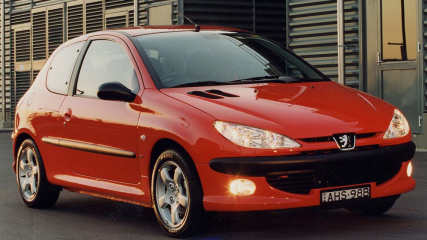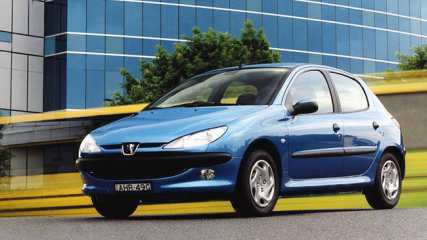Peugeot 206 2001 Review
By Paul Gover · 29 Jun 2001
The latest baby offering from Peugeot is sure to tempt the tastebuds without shocking your wallet. French cars will be more than just a side order on the Australian motoring menu in the next few years. Renault, Peugeot and Citroen each has plans to turn themselves into a main course, with cars that are more than just spice on the Aussie car barbecue.Renault is cooking up a storm with its Clio and Megane models, but no one should ignore Peugeot. It has the best long-term record in Australia, though it is headed for a change of agent later this year when Inchcape Motors surrenders the rights to the Sime Darby Group.The uncertainty about the changeover hasn't helped Peugeot sales this year, but jumping back into the baby 206 shows why shoppers shouldn't walk away from this French treat. The 206 has been around since the end of 1999, but a week with the 206 XT -- at the great price of $22,990 -- shows it's still on the pace.It also proves Peugeot was smart to add a gruntier 1.6-litre engine at the start of the year, even though it meant a minor price rise. The new twin-cam motor isn't a screamer, but has a useful 82kW of power against 67kW when it started. And torque is boosted from 137Nm to 147Nm.The good-looking 206 has always been one of the most distinctive cars on the road. It is roomy and comfortable for the class and now gets along surprisingly well, to make it tastier showroom bait. The XT, the middle model in the 206 range, has never stepped out of the shadow of its sporty leader, the six-speed and 2-litre GTi, until now.It has also battled in a tough class, where popular Japanese cars led by the Nissan Pulsar and Toyota Corolla had it hemmed in on one side. Smart Euro opposition, such as the Volkswagen Polo and Holden's Astra, pinned it down on the other.The 206 is a sweet-looking car that's well equipped in the XT model. It has twin airbags, air-con, central locking, CD sound and electric windows and mirrors. Peugeot relies on the dynamics that give its cars one of the world's best ride and handling as well as a reputation for reliability that stretches back to the early days in Australia with the 404 and 504.Today's lineup is impressive, running from the 206 to the 406 and the promise of plenty to come. There should be a 206 CC - for coupe-cabriolet, and with a metal folding roof - before the end of the year, as well as a fresh 307 next year and a full-sized luxury flagship called the 607.DrivingWHENEVER I see a 206, any model, I'm reminded of my favourite Peugeot, the wonderful little 205 GTi. The 205 was a ground-breaking hot hatch in the 1980s that changed Peugeot from a maker of quirky, but slightly dull cars that were virtually unbreakable. It had style, it had pace, and it was the way to get noticed.The XT isn't a GTi, but it has something special in the way it looks. And the way it drives. It can be pedalled along surprisingly briskly, using torque rather than top-end revs, though the car split the Cars Guide team. Some, including me, liked the old Mercedes-style shift pattern with a dogleg movement to encourage manual changes. Others found it difficult and baulky to use.The manual spent most time in the test shed and came through well. The XT is a five-door hatch that Peugeot has made the most of inside its baby body, but it's still never going to threaten a Pulsar or Corolla with people who want maximum space. It's roomy in the front, and not too bad in the back, but the boot is small and the overall cabin numbers trail most of its Asian rivals.It is pretty well built, but some of the plastic looks light and a run down a gravel road revealed a lot of stone noise under the wheels - a sign of a lightweight body without much protection below. If it were anything but a Peugeot I'd be worried, because it is noisy, but the company has always known how to make cars that last.The cabin has a slightly quirky rounded-body style, but the seats are comfy and the instruments and controls clear and simple. The driver's footwell is cramped, which means no room to stretch on highway runs, and that's been a constant complaint about compact Peugeots - the switch from left-hand-drive never seems to provide enough space, though at least the pedals are farther apart in the XT.The manual gearshift was light and easy to use, like the power steering, and the latest twin-cam engine was a delight. It felt more like a 1.8 in a first run in the automatic and had surprisingly strong mid-range surge, an impression cemented by the manual.The numbers aren't huge, but keeping the engine spinning in the 2000-4000-rev range liberates the bulk of power and torque and allows the XT to cover ground briskly. The engine gets a bit thrashy at the top end, another reason not too push too hard, but it always hooks up strongly with the next gear and the throttle response is excellent.The XT's ride was among the very best for a small car, but handling is worrying. The front end grips well, and it is balanced in slow corners, but pushing too briskly in quick corners can unsettle the tail. Still, the brakes are good, the horn fair and the headlights brilliant.I've overlooked the 206 in recent times, but the extra go from the new engine, combined with good-value prices, has revitalised its appeal.The bottom line3/5 Sporty; well priced.* One of the hidden jewels in the small car ranks.Peugeot 206 XT Price: Manual $22,990 as testedEngine: 1.6-litre four-cylinder with double overhead camshafts and fuel injectionPower: 82kW at 5750revsTorque: 147Nm at 4000revsTransmission: five-speed manual, front-wheel-driveBody: four-door hatchbackDimensions: Length 3835mm, width 1652mm, height 1432mm, wheelbase 2442mm tracks 1425mm/1416mm front/rearWeight: 1100kgFuel Tank: 50 litresFuel Consumption: average on test 8.6 litres/100kmSteering: power-assisted rack-and-pinionSuspension: fully independent with front MacPherson struts and trailing arm rear with anti-roll barsBrakes: four-wheel discsWheels: 5.5x14Tyres: 185/65 R14Warranty: two years/unlimited kilometres











